This game ended up around 2 hours long; if you’re interested in trying it, the Commodore 64 version is fine (link to play online). As far as *if* you should play it — if the idea of playing the first gamebook-form computer game appeals to you, or playing the first Lovecraft game in any form, then yes, try it out.
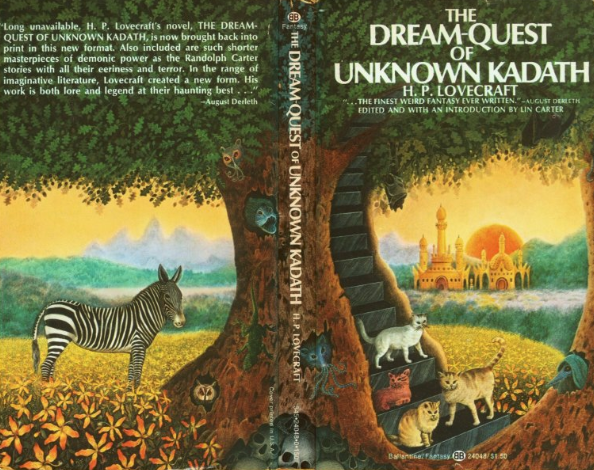
Cover via ISFDB; after this point are complete spoilers.
I. On the pentagonal map trick
Last time, I mentioned each main room of the game has five exits, and when you enter a room you specify where you go by a number (1, 2, 3, or 4) where the numbers represent the exits clockwise.
It worked for this game, but it wouldn’t work generally.
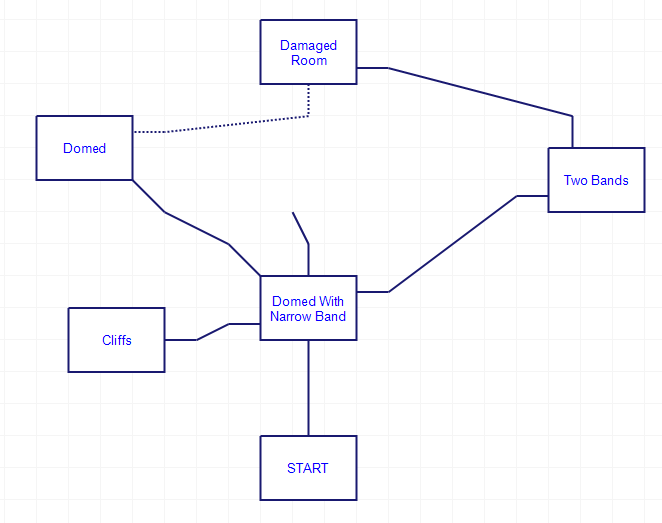
The map above is partial, but more or less represents my own game mid-play. I had mapped out the “Domed Narrow Band” room, “Two Bands” room, and “Domed” room. I just added the “Damaged” room and tried another exit, which brought me back to the “Domed” room.
But: where in the Domed room did I just arrive? There’s already a known connection (to the “Domed Narrow Band”) but I had no idea where the new passage is relative to the known one; that meant I couldn’t merge my new passage with what was there. In other words, the “known passage” could have been any number from 1 to 4. Figuring this out involved a lot of error and redraws of my map.
The author clearly knew his map was confusing and amplified the effect. You might go through a passage to a room and find there is a door to the left and a door to the right going back (that weren’t mentioned before) to find only one of them goes back to the original room … or even find *both* of them go back to the original room, but one of them is to a different exit (so the numbers 1 to 4 now correspond to entirely different places).

In fact, I’m fairly sure my current map is far off from the real one, so I’m not going to reproduce the whole thing here. It turns out the winning sequence is short so I just needed a sequence that worked, rather than thoroughly understanding how everything connected.
II. So far
The game gives “progress reports” at regular intervals, and one more report when you die.
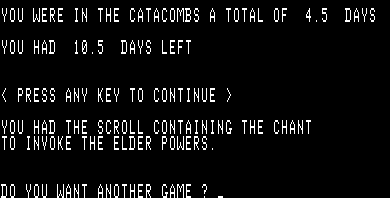
This was, in essence, akin to a “Story So Far” type update where a game gives you a running narrative of what’s happened so far if you restore a saved game file. (I most recently saw this in Heaven’s Vault, but it’s very rare in general.)
The reminder of days remaining serves to keep the tension up, and the mention of what items are found serves as fairly strong hints.
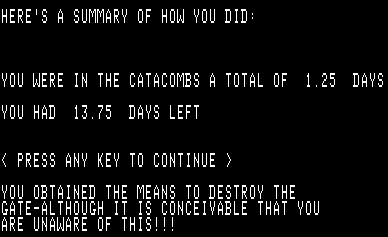
III. Instant death
There are no shortage of places to die. Some of them require you to actively take the final plunge.

Where could so many bones have possibly come from? Maybe I should get closer and check it out?
Some of them are a little more arbitrary.

I went the wrong direction.
IV. How inventory is handled
You’ll occasionally find an item; the game will either prompt if you want to take it with you, or in some cases if there’s more than one item, which one you want to take.
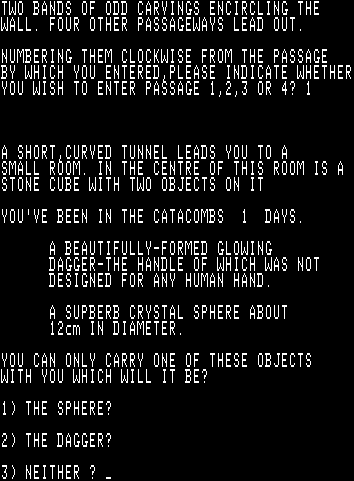
The “which item to take” complication keeps the puzzles from being too simplistic … but only barely. My first time through I had taken the sphere. Later I found an “AMORPHOUS BLOB” where my only option was to run away, and the game frets over my lack of a weapon. So … return to swap the sphere for the dagger, come back, and then I could use the dagger on the blob.

V. On winning
The start of the game states you need to
find and return the Eye of Kadath
invoke the Elder powers
destroy the Gate
The “story so far” bits helpfully fill in when you’re ready, so it’s just a matter of going to the right location and … typing?

This felt weirdly like a trivia quiz, but I suppose the effect was better than having everything done automatically. Having to type the chant was a nice touch, except my first time through I messed it up because my emulator’s apostrophe button was a different-than-usual key, causing the universe to be destroyed. (Little did we realize humanity’s fall would be due to keyboard mapping.)
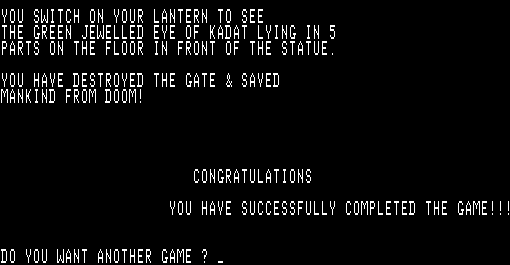
This game was just the right length to get across the Lovecraftian sense of dread and confusion without overstaying its visit.
VI. On the gamebook connection
My main question by the end was (and still is) “where did Gary Musgrave get the idea for this?”
While there are many gamebooks that came before, Kadath doesn’t resemble any of them that closely (and I hope the numerous re-inventions I mentioned in my short history attest to the fact it’d be possible to be writing in 1979 while still unaware of all of them). Primarily, the choice books before that point had each numbered section as a plot-point but not as a physical location in space, and the idea of returning to prior locations in loops would be doubly weird. If anything, he may have been familiar with the Tunnels and Trolls games, but even those emphasized forward progress and were more into RPG elements than puzzles.
In other words, this may have represented yet another re-invention of the gamebook form. Cave of Time (the first Choose-your-own-Adventure) wasn’t out until July of 1979, the same month this game was released. Could this have been made immediately after the author saw Cave of Time (assuming, of course, he saw it in the first place)? While possible, it seems too heavily morphed from the CYOA concept to be a rush job.
We have seen some menu-based adventure games: Treasure Hunt (1978), Quest (1978) and Mines (1979) all qualify. Even if Mr. Musgrave hadn’t played them, it wouldn’t be too complex a leap from menu-based adventure as a concept to a game with more active plot choices, attempted atmosphere writing, and choices involving an inventory.
There’s also some element of text simulation-narrative games, yet another genre I haven’t written much about. Compare the march of time to that of, say, Camel (link to play online).
You have travelled 0 miles altogether.
What is your command? 2
Your camel likes this pace.
You have travelled 9 miles altogether.
What is your command? 3
Your camel is burning across the desert sands.
———-W A R N I N G———- Get a drink
You have travelled 23 miles altogether.
Alternately, note how in early versions of Oregon Trail you have to type BANG correctly while hunting. Compare this to the ending of Kadath where you have to type the chant. (I never verified if the typing was timed, but the game did indicate you needed to hurry.)
Whatever the original source of creativity, I appreciated this game was rescued from the depths by being ported off the Altair. If you’re wondering when the first “straight CYOA game” for computer happened (that is, one designed specifically for computer that only goes from node to node, with no inventory or the like), we’ll need to return to 1980 and a famous disaster that killed over 50 people.
I would not name, personally, the very first computerized gamebook/CYOA (I mean, friendly disagreeing about nitpicking nomenclature here, and better with a pair of beers), precisely because of what you said, the nodes are not there to support a narrative, always forward. On the contrary, it just seems a typical model world where the author decided to use a choice based interface instead of a parser because of reasons.
So the question for me is: could this be printed straight to paper for a gamebook format?
Anyway, of course, there are gamebooks that support a model world of re-visitable locations (Fabled Lands series, I wonder if Fabled Lands series are the first instance of an open world in paper gamebooks).
So, regards Kadath the question is. There are previous instances of text games with the model world that uses a choose based interface? (*COUGH* Wumpus *COUGH*)
Citing a quote from the last article about Journey by CRPG Addict, do “it takes a reactive computer can do that a non-reactive book cannot”? So, could we define Kadath as a “reactive computer game” vs the typical non-reactive paper gamebook? (taking in mind that one can simulate inventory and puzzles in gamebooks too, using character sheets, inventory or just keywords for the player to keep an inventory of. For example, if you have the dagger, turn to page 56, if not, FACE THE BLOB!).
I would say YES, just because the orientation (disorientation) system seems dynamic. So, I would categorize Kadath as a “choice based text adventure”.
Anyway, I like too that you must type in the last chant to win the game. Even, that could be made as a puzzle of knowledge, about retaining the chant or deciphering it or something.
And now, a new idea. CRPG Addict talked informally about “best game of the year”, and I think this is a really cool idea for your blog project. Maybe a separate page, or a badge to name the very best adventure of each year (in your opinion). Maybe a list at IFDB could do the work. That would make a nice suggestion list of games to play… now I remember you made something similar or talked about when mentioning The Count… anyway, a more “Blue’s official GOTY list” could be really neat.
You could make this in book form with only a few tweaks — you’d need to have the player keep track of inventory, but there isn’t anything here a Fighting Fantasy book hasn’t done.
Obviously, the typing at the end wouldn’t be possible.